Who Is More Likely to Define Unrelated Roommates as a Family?
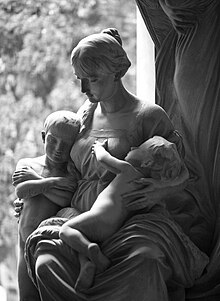
A female parent is the mother of a kid. Mothers are women who inhabit or perform the role of bearing some relation to their children, who may or may not exist their biological offspring. Thus, dependent on the context, women can be considered mothers by virtue of having given birth, by raising their child(ren), supplying their ovum for fertilisation, or some combination thereof. Such conditions provide a way of delineating the concept of maternity, or the country of being a female parent. Women who meet the third and first categories normally fall nether the terms 'birth mother' or 'biological mother', regardless of whether the individual in question goes on to parent their kid. Accordingly, a woman who meets only the second status may be considered an adoptive female parent, and those who run across but the starting time or only the third a surrogacy mother.
An adoptive mother is a female who has become the child's parent through the legal process of adoption. A biological mother is the female person genetic correspondent to the creation of the infant, through sexual intercourse or egg donation. A biological female parent may take legal obligations to a child not raised by her, such as an obligation of monetary support. A putative female parent is a female person whose biological relationship to a child is alleged merely has not been established. A stepmother is a woman who is married to a child's father and they may form a family unit unit, simply who generally does not have the legal rights and responsibilities of a parent in relation to the kid.
The above concepts defining the role of female parent are neither exhaustive nor universal, as any definition of 'mother' may vary based on how social, cultural, and religious roles are defined. There are parallel weather condition and terms for males: those who are (typically biologically) fathers do not, by definition, take up the office of motherhood. Motherhood and fatherhood are not express to those who are or have parented. Women who are pregnant may be referred to as expectant mothers or mothershoped-for, though such applications tend to exist less readily applied to (biological) fathers or adoptive parents.[one] [2] The procedure of becoming a mother has been referred to as "matrescence".[3]
The describing word "maternal" refers to a mother and comparatively to "paternal" for a father. The verb "to mother" means to procreate or to sire a child, or to provide treat a kid, from which also derives the substantive "mothering".[4] Related terms of endearment are mom (mama, mommy), mum (mummy), mumsy, mamacita (ma, mam) and mammy. A female role model that children can await up to is sometimes referred to equally a mother-figure.
Types of motherhood
A true cat feeding its kittens
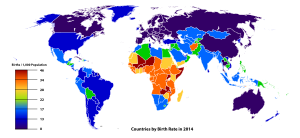
Countries by crude birth rate (CBR) in 2014. Birth rates are lowest in Western countries.
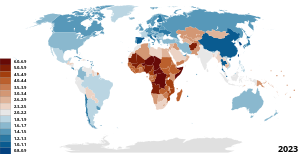

Biological mother
Biological motherhood for humans, as in other mammals, occurs when a pregnant female gestates a fertilized ovum (the "egg"). A female can get pregnant through sexual intercourse subsequently she has begun to ovulate. In well-nourished girls, menarche (the first menstrual period) commonly takes place effectually the age of 12 or 13.[5]
Typically, a fetus develops from the feasible zygote, resulting in an embryo. Gestation occurs in the woman's uterus until the fetus (bold it is carried to term) is sufficiently developed to be born. In humans, gestation is often around 9 months in duration, subsequently which the woman experiences labor and gives nascency. This is non ever the case, notwithstanding, every bit some babies are born prematurely, belatedly, or in the example of stillbirth, practice not survive gestation. Usually, one time the babe is born, the mother produces milk via the lactation process. The mother'southward breast milk is the source of antibodies for the babe'south immune organization, and commonly the sole source of diet for newborns earlier they are able to eat and digest other foods; older infants and toddlers may continue to exist breastfed, in combination with other foods, which should be introduced from approximately six months of age.[six]
Childlessness is the state of not having children. Childlessness may have personal, social or political significance. Childlessness may be voluntary childlessness, which occurs by selection, or may be involuntary due to health issues or social circumstances. Maternity is usually voluntary, but may also be the result of forced pregnancy, such as pregnancy from rape. Unwanted motherhood occurs especially in cultures which practise forced marriage and child marriage.
Non-biological female parent
Mother tin can often apply to a woman other than the biological parent, especially if she fulfills the main social part in raising the child. This is normally either an adoptive mother or a stepmother (the biologically unrelated partner of a kid's father). The term "othermother" or "other mother" is too used in some contexts for women who provide intendance for a child non biologically their ain in improver to the child's primary mother.
Adoption, in various forms, has been skilful throughout history, fifty-fifty predating human civilisation.[7] Modern systems of adoption, arising in the 20th century, tend to exist governed by comprehensive statutes and regulations. In recent decades, international adoptions take go more and more than mutual.
Adoption in the The states is common and relatively piece of cake from a legal point of view (compared to other Western countries).[viii] In 2001, with over 127,000 adoptions, the United states accounted for virtually half of the total number of adoptions worldwide.[ix]
Surrogate mother
A surrogate female parent is a woman who bears a child that came from another adult female's fertilized ovum on behalf of a couple unable to give birth to children. Thus the surrogate mother carries and gives nascence to a child that she is not the biological mother of. Surrogate motherhood became possible with advances in reproductive technologies, such as in vitro fertilization.
Non all women who become pregnant via in vitro fertilization are surrogate mothers. Surrogacy involves both a genetic female parent, who provides the ovum, and a gestational (or surrogate) mother, who carries the child to term.
Lesbian and bisexual motherhood
The possibility for lesbian and bisexual women in aforementioned-sex relationships to become mothers has increased over the past few decades[ when? ] due to technological developments. Modern lesbian parenting originated with women who were in heterosexual relationships who later on identified as lesbian or bisexual, equally irresolute attitudes provided more acceptance for non-heterosexual relationships. Other ways for such women to become mothers is through adopting, foster parenting or in vitro fertilization.[10] [11]
Transgender motherhood
Transgender women may have biological children with a partner by utilizing their sperm to fertilize an egg and class an embryo.[12] [13] For transgender women, at that place is currently no accessible way to behave a child. Yet, enquiry is being done on uterus transplants, which could potentially allow transgender women to behave and give birth to children through Caesarean section. Other types of motherhood include adoption or foster patenting. Nonetheless, adoption agencies often refuse to work with transgender parents or are reluctant to do and then.[fourteen] [fifteen]

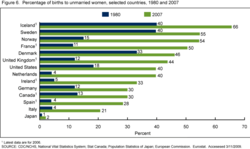
Pct of births to unmarried women, selected countries, 1980 and 2007.[16]

Olga Pearson Engdahl was American Mother of the Yr in 1963[17]
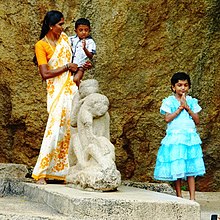

Nomad female parent and son. Changtang, Ladakh
The social roles associated with motherhood are variable beyond fourth dimension, culture, and social course. [18] Historically, the office of women was confined to some extent to existence a mother and married woman, with women being expected to dedicate most of their energy to these roles, and to spend most of their time taking care of the home. In many cultures, women received pregnant aid in performing these tasks from older female person relatives, such as mothers in police or their ain mothers.[nineteen]
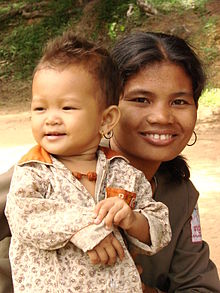
Regarding women in the workforce, mothers are said to oftentimes follow a "mommy track" rather than being entirely "career women". Mothers may exist stay at home mothers or working mothers. In recent decades there has been an increase in stay at home fathers too. Social views on these arrangements vary significantly past civilization: in Europe for instance, in High german-speaking countries there is a strong tradition of mothers exiting the workforce and being homemakers.[20] Mothers accept historically fulfilled the primary function in raising children, merely since the late 20th century, the office of the begetter in child care has been given greater prominence and social acceptance in some Western countries.[21] [22] The 20th century also saw more and more women entering paid piece of work. Mothers' rights within the workforce include motherhood leave and parental get out.
The social office and experience of motherhood varies greatly depending upon location. Mothers are more likely than fathers to encourage assimilative and communion-enhancing patterns in their children.[23] Mothers are more than likely than fathers to acknowledge their children's contributions in conversation.[24] [25] [26] [27] The mode mothers speak to their children ("motherese") is better suited to support very immature children in their efforts to understand speech (in context of the reference English language) than fathers.[24]
Since the 1970s, in vitro fertilization has fabricated pregnancy possible at ages well across "natural" limits, generating ethical controversy and forcing significant changes in the social meaning of motherhood.[28] [29] This is, however, a position highly biased past Western earth locality: exterior the Western world, in-vitro fertilization has far less prominence, importance or currency compared to primary, basic healthcare, women'southward basic wellness, reducing infant mortality and the prevention of life-threatening diseases such as polio, typhus and malaria.
Traditionally, and still in nigh parts of the world today, a mother was expected to be a married woman, with nascency exterior of marriage carrying a strong social stigma. Historically, this stigma not only applied to the mother, only besides to her child. This continues to be the case in many parts of the developing earth today, but in many Western countries the state of affairs has inverse radically, with unmarried motherhood being much more socially acceptable now. For more details on these subjects, run across Legitimacy (family constabulary) and single parent.
The total fertility rate (TFR), that is, the number of children built-in per woman, differs greatly from country to land. The TFR in 2013 was estimated to be highest in Niger (7.03 children built-in per woman) and lowest in Singapore (0.79 children/woman).[thirty]
In the Us, the TFR was estimated for 2013 at 2.06 births per adult female.[30] In 2011, the average age at first birth was 25.6 and 40.vii% of births were to single women.[31]
Wellness and prophylactic bug
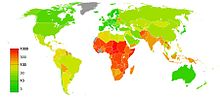
Maternal mortality map, given equally the annual number of female deaths per 100,000 alive births in 2012
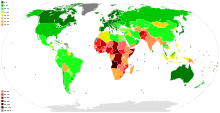
Infant mortality rates under age 1, per 1,000 live births in 2013

Sub-Saharan African countries carry the highest risks in terms of maternal and babe mortality and health.
A maternal expiry is defined by WHO as "the death of a adult female while pregnant or within 42 days of termination of pregnancy, irrespective of the elapsing and site of the pregnancy, from any cause related to or aggravated by the pregnancy or its management but not from accidental or incidental causes".[32]
Near 56% of maternal deaths occur in Sub-Saharan Africa and some other 29% in South asia.[33]
In 2006, the organization Save the Children has ranked the countries of the world, and constitute that Scandinavian countries are the safest places to requite birth, whereas countries in sub-Saharan Africa are the least safe to requite birth.[34] This study argues a female parent in the bottom ten ranked countries is over 750 times more likely to die in pregnancy or childbirth, compared to a mother in the top ten ranked countries, and a mother in the bottom ten ranked countries is 28 times more than likely to see her kid die earlier reaching their first birthday.
The most contempo data suggests that Italy, Sweden and Luxembourg are the safest countries in terms of maternal death and Transitional islamic state of afghanistan, Cardinal African Republic and Malawi are the most dangerous.[35] [36]
Childbirth is an inherently dangerous and risky procedure, subject area to many complications. The "natural" bloodshed rate of childbirth—where nothing is done to avert maternal death—has been estimated as being 1500 deaths per 100,000 births.[37] Modern medicine has greatly alleviated the risk of childbirth. In modernistic Western countries the electric current maternal mortality rate is around 10 deaths per 100,000 births.[38]
Religious
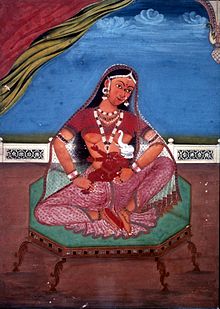
About all earth religions define tasks or roles for mothers through either religious police or through the glorification of mothers who served in substantial religious events. There are many examples of religious law relating to mothers and women.
Major world religions which accept specific religious constabulary or scriptural canon regarding mothers include: Christianity,[39] Judaism,[40] and Islam.[41] Some examples of honoring motherhood include the Madonna or Blessed Virgin Female parent Mary for Catholics, and the multiple positive references to agile womanhood as a mother in the Volume of Proverbs.
Hindu'due south Mother Goddess and Demeter of aboriginal Greek pre-Christian belief are also mothers.
Mother-offspring violence

History records many conflicts between mothers and their children. Some fifty-fifty resulted in murder, such equally the conflict between Cleopatra 3 of Arab republic of egypt and her son Ptolemy X.
In mod cultures, matricide (the killing of one'due south mother) and filicide (the killing of ane'south son or girl) have been studied but remain poorly understood. Psychosis and schizophrenia are mutual causes of both,[42] [43] and immature, indigent mothers with a history of domestic abuse are slightly more than probable to commit filicide.[43] [44] Mothers are more probable to commit filicide than fathers when the child is 8 years old or younger.[45] Matricide is near frequently committed by adult sons.[46]
In the United states of america in 2012, there were 130 matricides (0.4 per one thousand thousand people) and 383 filicides (ane.ii per million), or 1.4 incidents per day.[47]
In art


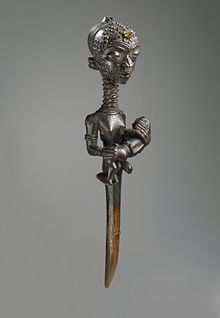
This Congolese effigy was used to protect women who had lost successive children to miscarriages or baby decease and is considered one of the great masterpieces of African Art. Brooklyn Museum
Throughout history mothers with their children have oft been the subject of artistic works, such as paintings, sculptures or writings.
4th century grave reliefs on the island of Rhodes depicted mothers with children.[48]
Paintings of mothers with their children have a long tradition in France. In the 18th century, these works embodied the Enlightenment's preoccupation with strong family bonds and the relation betwixt mothers and children.[49]
At the end of the nineteenth century, Mary Cassatt was a painter well known for her portraits of mothers.
Many contemporary movies portray mothers.
Synonyms and translations

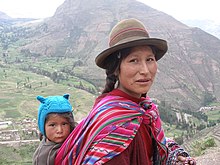
Mother with kid in Republic of peru

Mothers with children in liberated Guinea-bissau, 1974
The proverbial "first word" of an babe often sounds like "ma" or "mama". This stiff association of that audio with "mother" has persisted in nearly every language on earth, countering the natural localization of linguistic communication.
Familiar or colloquial terms for mother in English language are:
- Ma(মা), Mata (মাতা), Amma (আম্মা), Ammu (আম্মু) used in Bangladesh, India.
- Aama, Mata used in Nepal
- Mom and mommy are used in the United States, Canada, South Africa, and parts of the Westward Midlands including Birmingham in the Uk.
- Inay, Nanay, Mama, Ma, Mom, Mommy are used in the Philippines
- Mum and mummy and mama are used in the Great britain, Canada, Singapore, Australia, New Zealand, India, Islamic republic of pakistan, Hong Kong and Ireland.
- Ma, mam, and mammy are used in Netherlands, Ireland, the Northern areas of the Uk, and Wales; it is besides used in some areas of the United states of america.
In many other languages, similar pronunciations apply:
- Amma (அம்மா) or Thai (தாய்) in Tamil.
- Bi-ma (बिमा) in Bodo.
- Maa, aai, amma, and mata are used in languages of India like Assamese, Bengali, Hindi, Marä thi, Tamil, Telugu etc.
- Mamá, mama, ma, and mami in Spanish
- Mama in Polish, German, Dutch, Russian and Slovak
- Māma (妈妈/媽媽) in Chinese
- Máma in Czech and in Ukrainian
- Maman in French and Persian
- Ma, mama in Indonesian
- Mamaí, mam in Irish
- Mamma in Italian, Icelandic, Latvian and Swedish
- Māman or mādar in Farsi
- Mamãe or mãe in Portuguese
- Mā̃ (ਮਾਂ) in Punjabi
- Maa(ମା), Bou/Bau(ବୋଉ/ବଉ) in Odia
- Mama in Swahili
- Em (אם) in Hebrew
- A'ma (ܐܡܐ) in Aramaic
- Má or mẹ in Vietnamese
- Mam in Welsh
- Eomma (엄마, pronounced [ʌmma]) in Korean
- In many south Asian cultures and the Middle E, the mother is known every bit amma, oma, ammi or "ummi", or variations thereof. Many times, these terms denote amore or a maternal role in a child'south life.
Etymology
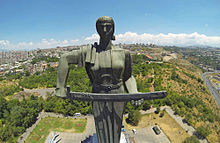
The modern English discussion is from Eye English language moder, from Old English mōdor, from Proto-Germanic *mōdēr (cf. Due east Frisian muur, Dutch moeder, German Mutter), from Proto-Indo-European *méh₂tēr (cf. Irish máthair, Tocharian A mācar, B mācer, Lithuanian mótė). Other cognates include Latin māter, Greek μήτηρ, Mutual Slavic *mati (thence Russian мать (mat')), Western farsi مادر (madar), and Sanskrit मातृ (mātṛ).
Notable mothers
- Bachue
- Bithiah
- Demeter
- Yashoda
- Dewi Sri
- Eve
- Gaia
- Isis
- Jocasta
- Juno
- Kösem Sultan
- Kwan Yin
- Mary
- Parvati
- Queen Maya
- Sita
- Venus
Zoology
In zoology, particularly in mammals, a mother fills many similar biological functions as a homo mother.
Mammals
Many other mammal mothers also have numerous commonalities with humans.
Primates
The behavior and role of mothers in non-human species is near like in species most closely related to humans. This means great apes are almost like, then the broader superfamily of all apes, then all primates.
Meet likewise
- Avant-garde maternal age
- Attachment parenting
- Blest Virgin Mary
- Breastfeeding
- Jungian archetypes
- Lactation
- Maternal bond
- Maternity packet
- Matriarch
- Matricide
- Matrilocal residence
- Mother goddess
- Female parent insult
- Maternity penalty
- Mother's Day
- Mothers' rights
- Nuclear family
- Oedipus complex
- Othermother
- Parenting
- Single-parent
References
- ^ "definition of mother from Oxford Dictionaries Online". Oxford Dictionaries. Oxford Academy Press.
- ^ "Ascertain Mother at Dictionary.com". Dictionary.com.
- ^ Sacks, Alexandra (8 May 2017). "The Nativity of a Mother". Retrieved nine September 2018.
- ^ "Definition of MOTHER". www.merriam-webster.com . Retrieved 2022-02-12 .
- ^ "Medscape: Medscape Access".
- ^ "Your baby's offset solid foods". nhs.united kingdom. 2017-12-21. Retrieved 2018-12-17 .
- ^ Peter Conn (28 Jan 2013). Adoption: A Brief Social and Cultural History. Palgrave Macmillan. pp. 25–64. ISBN978-1-137-33390-2.
- ^ Jardine, Cassandra (31 Oct 2007). "Why adoption is and so easy in America". Telegraph. Archived from the original on 2022-01-11.
- ^ "Child Adoption : Trends and Policies" (PDF). United nations.org. Retrieved 2015-07-01 .
- ^ "Lesbian parenting: bug, strengths and challenges". Retrieved 2011-01-25 .
- ^ Mezey, Nancy J (2008). New Choices, New Families: How Lesbians Decide about Motherhood . Baltimore: Johns Hopkins University Press. ISBN978-0-8018-9000-0.
- ^ Halim, Shakera (2019-08-05). "Study shows sperm product for transgender women could still be possible". Health Europa . Retrieved 2021-12-12 .
- ^ "Reproductive Options for Transgender Individuals". Yale Medicine . Retrieved 2021-12-12 .
- ^ Kinkler, Lori A.; Goldberg, Abbie E. (2011-ten-01). "Working With What We've Got: Perceptions of Barriers and Supports Amongst Pocket-size-Metropolitan Aforementioned-Sexual activity Adopting Couples". Family unit Relations. 60 (4): 387–403. doi:10.1111/j.1741-3729.2011.00654.x. ISSN 0197-6664. PMC3176589. PMID 21949461.
- ^ Montero, Darrel (2014-05-20). "Attitudes Toward Aforementioned-Gender Adoption and Parenting: An Analysis of Surveys from xvi Countries". Advances in Social Piece of work. fifteen (ii): 444–459. doi:10.18060/16139. ISSN 2331-4125.
- ^ "Irresolute Patterns of Nonmarital Childbearing in the United States". CDC/National Center for Wellness Statistics. May 13, 2009. Retrieved September 24, 2011.
- ^ Website list Archived 2011-03-23 at the Wayback Car
- ^ Arendell, Terry (2000). "Conceiving and Investigating Motherhood: The Decade's Scholarship". Journal of Matrimony and Family. 62 (four): 1192–1207. doi:10.1111/j.1741-3737.2000.01192.x.
- ^ "The Changing Function of Women in Due north American Mammalogy" (PDF). Biology.unm.edu. Retrieved 2015-07-01 .
- ^ "Has childlessness peaked in Europe?" (PDF). Ined.fr . Retrieved 17 December 2017.
- ^ [1] Archived August 15, 2013, at the Wayback Motorcar
- ^ "ucgstp.org". Ucgstp.org. Archived from the original on 2008-02-25. Retrieved 2015-07-01 .
- ^ Ann G. Berghout Austin1 and T.J. Braeger2 (1990-10-01). "Gendered differences in parents' encouragement of sibling interaction: implications for the construction of a personal premise organisation". Fla.sagepub.com. Retrieved 2011-10-27 .
- ^ a b "Fathers' speech to their children: perfect pitch or tin ear?". Thefreelibrary.com. Retrieved 2011-10-27 .
- ^ Hladik, E.; Edwards, H. (1984). "A comparison of female parent-father speech in the naturalistic home environment". Journal of Psycholinguistic Research. 13: 321–332. doi:ten.1007/bf01068149. S2CID 144226238.
- ^ Leaper, C.; Anderson, G.; Sanders, P. (1998). "Moderators of gender furnishings on parents' talk to their children: A meta-analysis". Developmental Psychology. 34 (1): three–27. doi:10.1037/0012-1649.34.1.3. PMID 9471001.
- ^ Mannle, S.; Tomasello, 1000. (1987). "Fathers, siblings, and the span hypothesis". In Nelson, K. Due east.; vanKleeck, A. (eds.). Children'southward linguistic communication. Vol. vi. Hillsdale, NJ: Erlbaum. pp. 23–42.
- ^ "Motherhood: Is It E'er Likewise Late? | Jacob M. Appel". Huffingtonpost.com. 2009-08-15. Retrieved 2015-07-01 .
- ^ "Getting Pregnant After l: Risks, Rewards". Huffingtonpost.com. 2009-08-17. Retrieved 2015-07-01 .
- ^ a b "The World Factbook". cia.gov.
- ^ "FastStats". cdc.gov. 20 Oct 2021.
- ^ "WHO - Maternal mortality ratio (per 100 000 live births)". who.int. Archived from the original on May 7, 2013.
- ^ "Over 99 percent of maternal deaths occur in developing countries". worldbank.org.
- ^ [2] Archived October 12, 2007, at the Wayback Machine
- ^ Kevin Spak (14 April 2010). "Safest Place to Give Birth? Italian republic". Newser.
- ^ Rogers, Simon (2010-04-13). "Maternal mortality: how many women die in childbirth in your country?". The Guardian.
- ^ Van Lerberghe Due west, De Brouwere V. Of blind alleys and things that accept worked: history'south lessons on reducing maternal mortality. In: De Brouwere Five, Van Lerberghe W, eds. Safe motherhood strategies: a review of the evidence. Antwerp, ITG Press, 2001 (Studies in Health Services Organization and Policy, 17:7–33). "Where nix constructive is done to avert maternal death, "natural" mortality is probably of the order of magnitude of 1,500/100,000."
- ^ ibid, p10
- ^ "What The Bible Says Nearly Mother". Mothers Solar day World. Retrieved 2008-11-24 .
- ^ Katz, Lisa. "Religious Obligations of Jewish women". Nearly.com. Retrieved 2008-11-24 .
- ^ 'Ali Al-Hashimi, Muhammad. The Ideal Muslimah: The Truthful Islâmic Personality of the Muslim Adult female as Defined in the Qur'ân and Sunnah. Wisdom Enrichment Foundation, Inc. Archived from the original on 2002-03-02. Retrieved 2008-11-24 .
- ^ Bourget, Dominique; Gagné, Pierre; Labelle, Mary-Eve (September 2007). "Parricide: A Comparative Study of Matricide Versus Patricide". Journal of the American Academy of Psychiatry and the Constabulary. 35 (3): 306–312. PMID 17872550. Retrieved 2 July 2015.
- ^ a b West, Sara G. (Feb 2007). "An Overview of Filicide". Psychiatry. 4 (ii): 48–57. PMC2922347. PMID 20805899.
- ^ Friedman, SH; Horwitz, SM; Resnick, PJ (Sep 2005). "Child murder by mothers: a critical analysis of the current state of cognition and a research agenda". American Periodical of Psychiatry. 162 (nine): 1578–87. doi:x.1176/appi.ajp.162.9.1578. PMID 16135615.
- ^ Greenfeld, Lawrence A., Snell, Tracy 50. (1999-02-12, updated 2000-03-x). "Women Offenders". NCJ 175688. US Department of Justice
- ^ Heide, KM (Mar 2013). "Matricide and stepmatricide victims and offenders: an empirical analysis of U.S. arrest data". Behavioral Sciences & the Police. 31 (2): 301–14. doi:10.1002/bsl.2056. PMID 23558726.
- ^ "Crime in the United states: Murder Circumstances past Human relationship, 2012". U.South. Federal Bureau of Investigation. Retrieved three July 2015.
- ^ Women, Criminal offence and Penalty in Ancient Constabulary and Society, p. 234, at Google Books
- ^ Intimate Encounters: Honey and Domesticity in Eighteenth-century France, p. 87, at Google Books
Further reading
- Atkinson, Clarissa W. The Oldest Vocation: Christian Motherhood in the Medieval Due west (Cornell University Press, 2019).
- Cowling, Camillia, et al. "Mothering slaves: comparative perspectives on motherhood, childlessness, and the intendance of children in Atlantic slave societies." Slavery & Abolitionism 38#2 (2017): 223-231. online
- Du, Yue. "Concubinage and Motherhood in Qing China (1644–1911) Ritual, Law, and Custodial Rights of Holding." Journal of Family History 42.ii (2017): 162-183.
- Ezawa, Aya. Unmarried Mothers in Gimmicky Japan: Maternity, Class, and Reproductive Do (2016) online review
- Feldstein, Ruth. Motherhood in blackness and white (Cornell UP, 2018) in U.Southward. history.
- Griffin, Emma. "The Value of Motherhood: Understanding Motherhood from Maternal Absence in Victorian Britain." By & Nowadays 246.Supplement_15 (2020): 167-185.
- Healy-Clancy, Meghan. "The Family Politics of the Federation of Due south African Women: A History of Public Maternity in Women's Antiracist Activism" Signs: Journal of Women in Culture and Guild 42.4 (2017): 843-866 online.
- Hrdy, Sarah Blaffer. Mother nature: maternal instincts and how they shape the human species.
- Knight, R. J. "Mistresses, maternity, and maternal exploitation in the Antebellum South." Women's History Review 27.6 (2018): 990-1005 in The states.
- Lerner, Giovanna Faleschini, and D'Amelio Maria Elena, eds. Italian Motherhood on Screen (Springer, 2017).
- McCarthy, Helen. Double Lives: A History of Working Maternity (Bloomsbury, 2020), focus on Uk
- Manne, Anne. Motherhood – How should we care for our children?.
- Massell, Gregory J. The Surrogate Proletariat: Moslem Women and Revolutionary Strategies in Soviet Central Asia, 1919-1929 (Princeton Up, 1974).
- Njoku, C. O., and A. N. Njoku. "Obstetric Fistula: The Agony of Unsafe Motherhood. A Review of Nigeria Experience." Journal of Advances in Medicine and Medical Research (2018): 1-7 online.
- Portier-Le Cocq, Fabienne, ed. Motherhood in Gimmicky International Perspective: Continuity and Change (Routledge, 2019).
- Rahmath, Ayshath Shamah, Raihanah Mohd Mydin, and Ruzy Suliza Hashim. "Archetypal Motherhood and the National Agenda: The Case of the Indian Muslim Women." Space and Culture, Republic of india 7.4 (2020): 12-31 online.
- Ramm, Alejandra, and Jasmine Gideon. Maternity, Social Policies and Women'southward Activism in Latin America (Springer, 2020).
- Romero, Margarita Sánchez, and Rosa María Cid López, eds. Motherhood and Infancies in the Mediterranean in Antiquity (Oxford: Oxbow Books, 2018).
- Rye, Gill, et al., eds. Motherhood in literature and culture: Interdisciplinary perspectives from Europe (Taylor & Francis, 2017).
- Takševa, Tatjana. "Motherhood Studies and Feminist Theory: Elisions and Intersections." Journal of the Motherhood Initiative for Research and Customs Involvement 9.one (2018) online.
- Thornhill, Randy; Gangestad, Steven Westward. The Evolutionary Biology of Human Female Sexuality.
- Varma, Mahima. "Adoptive Motherhood in India: State Intervention for Empowerment and Equality." Contemporary Social Sciences 28#3 (2019): 88–101. online
- Vasyagina, Nataliya N., and Aidar M. Kalimullin. "Retrospective analysis of social and cultural meanings of motherhood in Russia." Review of European Studies 7#v (2015): 61–65.
- Williams, Samantha. Single Motherhood in the Urban center, 1700–1850 (Springer, 2018) in London. excerpt
- Woods, Elizabeth A. The Baba and the Comrade: Gender and Politics in Revolutionary Russia (Indiana UP, 1997), online review
External links
Source: https://en.wikipedia.org/wiki/Mother
0 Response to "Who Is More Likely to Define Unrelated Roommates as a Family?"
Post a Comment